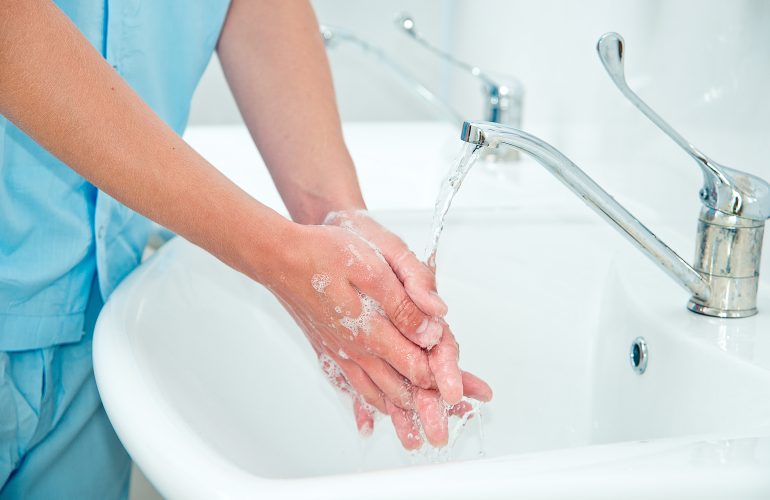Seniors living in long term care and other residential settings have a higher risk of developing infections and it’s up to us to minimize this risk and keep them safe. This is partially due to the diminished efficiency of their immune system as well as the environment itself. While this might not be the most exciting training programs, infection control education is absolutely necessary in these types of settings. There are a number of universal standards that must be employed to reduce risks of infection.
Types of Infections
Many types of infections can cause lots of problems in senior care including urinary tract infections (UTIs), lower respiratory infections, and outbreaks of gastrointestinal infections. These tend to be fairly common. There are other infections to be concerned about such as infected pressure ulcers, viral gastroenteritis, E coli, MRSA, scabies, conjunctivitis, just to name a few.
Some of these infections are communicable, meaning they can spread from person-to-person. This makes them particularly dangerous in senior residential settings filled with older adults. Some of these infections can spread like wild fire. It is critical to learn how to minimize the risk of spreading infections. You should know how to protect your residents, yourself and anyone else from getting a communicable infection.
Looking for Easy, Online CEUs?
Find Healthcare Compliance CEUs and many other subjects to fulfill your CE requirements.
Try a FREE CEU!
What Causes Infections?
Generally, there are two things that can cause infections: microbes and pathogens. There are many types of microbes including bacteria, viruses, fungi, or parasite. Some of these are harmless. Some are even helpful. Others can cause illnesses and disease. Pathogens, on the other hand, are the kinds of microbes that do cause disease. They require certain conditions to grow and multiply. They like warm, moist and dark environments to flourish. Some need oxygen and others don’t. It is important to keep residents and the environment clean and dry to reduce the risk of pathogens. The environment should also be well lighted to further reduce risk.
How are Infections Transmitted?
Infections can be transmitted in four ways: airborne, direct, oral-fecal and blood borne transmission. Airborne transmission means that infections are spread through the air by spraying particles of saliva or sputum (i.e. sneezing or coughing). TB, measles and chicken pox can spread this way. Direct transmission involves touching an infected individual or object. One result may be pink eye. Oral-fecal transmission means that the pathogen lives in a person’s digestive tract and leaves the body through feces. A person’s hands can become contaminated and then touch food or water. Once contaminated food or water is consumed, the infection spreads. And last, blood borne pathogens involve blood or other bodily fluids from an infected person coming into contact with another person through the bloodstream. This can occur by sharing needles, cuts from contaminated broken glass, direct contact between blood and broken skin, mucous membranes or eyes. Bodily fluids most like to contain blood borne pathogens include:
- Blood
- Semen
- Vaginal secretions
- Wound drainage
- Cerebrospinal fluid
- Amniotic fluid
- Breast milk
Types of infections caused by the blood borne transmission of pathogens include:
- Hepatitis B, C and D
- HIV and AIDS
Methods of Infection Control
Medical asepsis involves techniques to remove or destroy pathogens. Using soap and water, antiseptics, disinfectants and heat are common methods. The goal is to remove pathogens from surfaces, equipment, and the hands of all health care professionals. Wash those hands!
Four methods of medical asepsis are sanitation, antisepsis, disinfection and sterilization. Sanitation is basic and involves handwashing, cleaning eating utensils, using soap and water, and cleaning bed clothes. Antisepsis includes the use of mild chemical like rubbing alcohol and iodine to kill microbes or stop them from growing on the skin. Disinfection involves the use of strong chemicals like bleach to kill microbes on surfaces such as bedside tables and bed pans. And last, sterilization is the use of pressurized steam or very strong chemicals to kill microbes on equipment such as those used during surgery.
Final Words on Infection Control
Wash your hands. Practice effective infection control. Keep your patients or residents safe.
More About Healthcare Compliance
- HIPAA and Social Media: The Good, Bad and Ugly
- Elopement in Senior Care
- OSHA: 11 Areas to Know in Senior Care
- Falls and Aging
- Corporate Compliance 101
Looking for Easy, Online CEUs?
Find Healthcare Compliance CEUs and many other subjects to fulfill your CE requirements.
Click here for Healthcare Compliance CEUs

